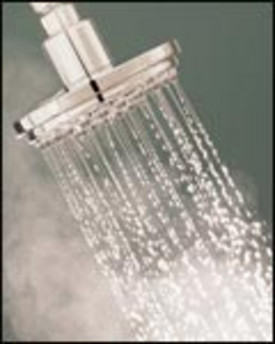Getting water when you want it, where you want it is a real balancing act. Pressurized water entering your house at the water main carries the energy to make it all work. Water is carried from the main to the various plumbed appliances in the house through pipes. The entire system must be designed to maintain good water pressure while reducing the initial pressure to safe, usable levels. Otherwise, you would blow out your kitchen faucet or showerhead. So, the system is designed to conserve the pressure while reducing it to a level that can be safely handled by each household appliance along the way.
Pressure is Everything
 |
||||
|
||||
A good plumbing system starts with good water pressure. The water that enters your home from the water main must have enough pressurized energy to provide a steady flow to all the sinks, toilets, and other plumbed appliances in the house. This pressure is measured by the amount of force it exerts per square inch of internal pipe space, or pounds per square inch (psi). That is a term you will hear and use when debating what size showerhead you can have or the size of pipe required to support the dishwasher.
When a faucet is turned on or a toilet is flushed, water in the supply pipes flows toward it. Pressure gets used up as it moves through the pipes from the main. However, that energy translates into water velocity, which is measured in gallons per minute. You need pressure to get velocity, and without velocity there would be no flow. Ultimately, it’s an energy transfer.
Individual plumbing components are designed to operate within limited ranges of pressure and flow. They cannot handle the full force of the pressure coming from the water main. A kitchen faucet designed to provide a maximum flow of six gallons per minute cannot be safely connected to a supply pipe that delivers one hundred gallons per minute from the main. So, by design the pressure coming in from the main is gradually reduced through successively smaller diameter pipes in an effort to supply quantity and pressure to all fixtures.
Keeping it Flowing
In addition to bringing each appliance the right amount of pressure, the supply system must also allow several fixtures and appliances to function at the same time. That is why system design is so important to water pressure and flow. If there were only one supply main in the house, each open appliance would reduce pressure and increase velocity until all you had was a trickling shower at the end of the line. But operating the dishwasher shouldn’t mean that no one can take a shower or that none of the toilets can be flushed. To solve this problem, supply systems are designed with two or more feeder pipes that branch off from the main and distribute water to different areas of the house. Having several feeder pipes rather than one continuous supply pipe running through the entire house eases the fluctuations in pressure that occur when an appliance is used.
A Well-Designed System
A plumbing contractor anticipates the likely demands on the water supply system at various times of day, adds in gravity, and plans the supply network accordingly. The trick is to balance the need for large pipes and pressure, with the need to reduce pressure and travel to distant appliances. The end result should be a well-designed system with good, steady flow at peak usage times.
Before planning a major renovation that includes plumbed fixtures, take a hard look at the current water pressure throughout the house. Then determine whether there is enough pressure to accommodate another plumbing appliance. Poor pressure doesn’t necessarily mean that you can’t add on. Your system may not be taking full advantage of the water pressure entering the home at the water main. Replacing some of the pipes in the water supply network could boost your pressure, but it might also add considerably to the overall cost of the renovation. Again, balance your desires with the possibilities and your overall budget. A good plumbing design should help you bring them all together.
Credit: Renovate Your World




























